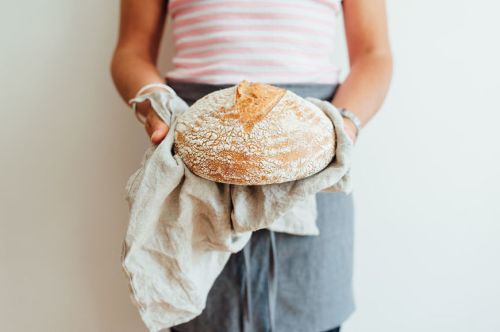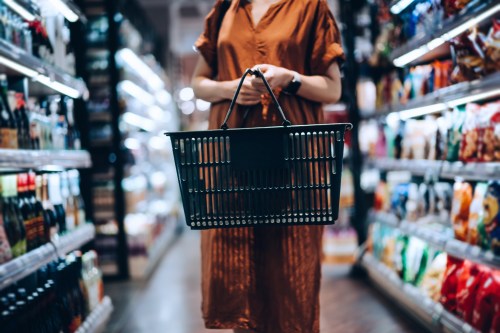Our editors independently select these products. Making a purchase through our links may earn Well+Good a commission
Generally speaking, health food experts eschew most baked goods, but there’s one healthy bread variety that still seems to get their approval: sourdough. Even food advocate Michael Pollan—who famously advises eating mostly plants—gives sourdough the thumbs up.
Why? The fermented dough makes it good for your gut. “[The] tradition of fermenting flour with sourdough breaks down the peptides in gluten that give people trouble,” Pollan previously told Well+Good. He said that many people who have digestive problems after eating other glutenous foods don’t have the same troubles with sourdough.
But making sourdough bread (or any kind of bread, really) can be intimidating—there’s the yeast, the mysterious “sourdough starter,” the whole having to knead it thing. Seems so complicated! To get all the facts, I took these questions (and many more) to Artisan Sourdough Made Simple author and The Clever Carrot blogger Emilie Raffa. Keep reading for everything you need to know.
What to know before you start baking
First of all, Raffa says that while sourdough bread-making can sound complicated, she says you absolutely shouldn’t be intimidated and even advises against doing too much research before you start. “Stop reading and comparing recipes,” she says. “There’s so much information out there with different methods and confusing terminology, it’s easy to fall down the rabbit hole and give up altogether.” Instead, she says just look for a good beginner recipe (the simpler, the better) and jump right in. “Don’t overthink it. That’s how I got started,” she says.
You also don’t need to have a bread machine or any other fancy gadget to make sourdough bread, Raffa says. “A bread machine will knead the dough for you and keep it warm during the rising process. However, these days most bread recipes are no-knead to begin with,” she says. “Plus, using a machine—instead of your hands—keeps you from touching the dough which is an integral part of the process.” Rolling up your sleeves and connecting to the food you’re making is part of what makes making your own sourdough bread so special.
What ingredients you need for sourdough bread
While sourdough bread recipes may vary, their ingredients lists tend to include the following basic essentials: flour, milk or water, olive oil, and sourdough starter.
In case you’re not familiar, sourdough starter is a live fermented culture of flour and water, says Raffa. “Once [the starter] becomes bubbly and active, a small portion is added to the bread dough to make it rise. Magical, right?” According to Raffa, as long as you have a sourdough starter, you don’t need instant yeast (although some recipes do call for it). You can buy sourdough starter kits online or DIY it in the kitchen before making your bread.
Most basic sourdough recipes use water, but some do call for milk; if you’re dairy-free, Raffa says alternative milks can work just as well. “In my experience, dairy milk can easily be swapped out for an alternative option, so feel free to use oat milk, almond milk, cashew milk…whatever you want. As long as you keep the original quantities the same, you should be good to go.”
However, Raffa says the flour can’t be exchanged one-for-one for a gluten-free version. “The flour matters big time,” she says—it influences the structure, texture, and the rise of the bread. “For traditional sourdough bread, regular high-protein bread flour or all-purpose flour is best. You can’t swap in alternative gluten-free flours and expect the same results.” You’d need to scout out a specific gluten-free recipe and starter, since even most starters are made with wheat flour.
The basics on how to make sourdough bread
Once you have your ingredients, you’re ready to start bread making, which Raffa explains in detail how to do in her book and on her site. The short version: you’ll mix your wet and dry ingredients together until they form into a dough, then let it rest and rise for several hours. During the period where the dough is resting, you work your dough periodically with the “stretch and fold” method, where you pull sections of it as far out as your can without tearing it, fold it back into the dough ball, then rotate the dough and repeat until you’ve done this all the way around the dough ball.
When the dough has doubled in size, Raffa recommends cutting it in half and then shape each half on a cutting board to get the round shape you want. Then put the dough inside a Dutch oven or another covered baking dish and let it rise again for another few hours. Slash a small cut into the top of the dough, then bake it for about 60 minutes total (20 minutes with the lid on, then 40 minutes with the lid off) until golden brown.
“If I had one additional tip for this, I’d say bake in a Dutch oven or some kind of covered pot that can withstand high heat. This is key. It traps in steam which is essential for a crisp crust and lofty, high rise,” Raffa says.
Raffa says sourdough bread is an art and part of the fun is the different ways it comes out. “My bread will never look like yours, or your friend’s, or that beautiful creation on Instagram. And it shouldn’t,” she says. “Go at your own pace. Get to know the dough and enjoy the process. Sourdough is an ongoing journey of self discovery that’s delicious to eat and share, for both beginners and seasoned bakers alike.”
Sprouted bread is also a good gut-healthy choice and this vegan banana bread recipe makes good use of rotten bananas.
Sign Up for Our Daily Newsletter
Get all the latest in wellness, trends, food, fitness, beauty, and more delivered right to your inbox.
Got it, you've been added to our email list.











